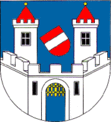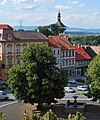Roudnice nad Labem
| Roudnice nad Labem | ||||
|---|---|---|---|---|
|
||||
| Basic data | ||||
| State : |
|
|||
| Historical part of the country : | Bohemia | |||
| Region : | Ústecký kraj | |||
| District : | Litoměřice | |||
| Area : | 1667.4019 ha | |||
| Geographic location : | 50 ° 25 ' N , 14 ° 15' E | |||
| Height: | 195 m nm | |||
| Residents : | 12,967 (Jan 1, 2019) | |||
| Postal code : | 413 01 | |||
| License plate : | U | |||
| traffic | ||||
| Railway connection: | Prague - Dresden | |||
| structure | ||||
| Status: | city | |||
| Districts: | 2 | |||
| administration | ||||
| Mayor : | Vladimír Urban (Status: 2013) | |||
| Address: | Karlovo náměstí 21 413 01 Roudnice nad Labem |
|||
| Municipality number: | 565555 | |||
| Website : | www.roudnicenl.cz | |||
Roudnice nad Labem (German Raudnitz an der Elbe ) is a city in the northern Bohemian Aussiger region in the Czech Republic . It is located on the left bank of the Elbe near the 456 m high Říp (Sankt Georgsberg) , around which the legend of the forefather Čech is entwined.
history
The settlement of Roudnice was first mentioned in 1167. At that time it belonged to the Prague bishops and received under Bishop Heinrich Břetislav III. a Romanesque castle based on the French model. In 1237, King Wenzel I granted Raudnitz city rights according to Leitmeritz law. It experienced a heyday in the 14th century: under Bishop John IV of Dražice , construction of the Wenceslas Church began and a stone bridge was built over the Elbe. Archbishop Ernst von Pardubitz founded the monastery of the Augustinian canons in 1343 and had the city fortified. Archbishop Johann Očko von Wlašim initiated renovation work on the episcopal castle. In addition, shortly before his death in 1378, he transferred the previous city rights to the "Neustadt".
During the Hussite Wars , Raudnitz was burned down in 1421 and 1425. After the death of Archbishop Konrad von Vechta , who was relieved of his offices in 1425 and died in 1431 in the episcopal Raudnitz Castle, the Archbishopric of Prague was administered by administrators from 1434 to 1561 . As a result, the episcopal castle lost its importance and Raudnitz came to frequently changing secular lords during this time.
In 1575 the Archdiocese of Prague sold Raudnitz to the Count of Bohemia, Wilhelm von Rosenberg , under whom the ruined castle and stone bridge were renovated. After his death in 1592, Raudnitz inherited his widow Polyxena von Pernstein . In 1603 she married the Chancellor of Bohemia, Zdeněk Vojtěch Popel von Lobkowitz , who built a Capuchin monastery in 1615/28 and had the Wenceslas Church renovated. Raudnitz now served as the headquarters of the Lords of Lobkowitz , under whom it developed into a center of the Counter Reformation . After the destruction of the Thirty Years War , the damage was repaired under Wenceslaus Eusebius von Lobkowicz . In addition, he began to build Raudnitz Castle from 1652, which was built on the foundations of the former bishop's castle according to the design of the builders Antonio della Porta and Francesco Caratti and which became of art historical importance beyond the border of Bohemia to Franconia . Completed under Ferdinand August von Lobkowitz (1655–1715) in 1684, it was equipped with a picture gallery and other art treasures. It also received a rich library, which also contained a gospel book from the 10th century.
In 1804 one of the first performances of Beethoven's Eroica took place at Raudnitz Castle at the instigation of Franz Joseph Maximilian Lobkowitz .
In addition to the Lobkowitz manor economy, chemical and metalworking companies have been of economic importance since the 19th century. In the second half of the 19th century, a Czech-national movement strengthened in Raudnitz, which was mainly populated by the Czechs , with the national monument of Říp (Georgsberg) , located five kilometers south-east of Raudnitz, playing a role. After the establishment of Czechoslovakia in 1918, the Lobkowitzes lost part of their possessions through the land reform of 1920, and after the Second World War they were entirely expropriated. The German-speaking inhabitants were based on the 1945 Benes decrees expelled . The castle, the valuable interior of which was lost or partly moved to other castles or museums, served as a military music academy from 1957. After the Velvet Revolution in 1991 a restitution was made by what was then Czechoslovakia to the von Lobkowitz family.
City structure
The town of Roudnice nad Labem consists of the districts Podlusky ( Podlusk ) and Roudnice nad Labem ( Raudnitz an der Elbe ), which also form cadastral districts. Basic settlement units are Bezděkov, Bezděkov-průmyslový obvod, Hracholusky, Ke Chvalínu, Nad Skalami, Nemocnice, Ostrov, Podlusky, Průmyslový obvod, Rejdiště, Roudnice nad Labem-středky, Sídlišté-Slav-středky, Sídlišté-Hracholíštěky, Sídlišté, Slav-střištky, Sídlišté-Hracholíštěky, Sídlišté, Slacholíštředky, Hracholíštěk, Sídlišté-Hracholíštěky. U Podlusků, U stadionu, Uličky, Urbanka, Za rozhlednou and Zahrady.
Town twinning
-
 Albaida , Spain
Albaida , Spain -
 Amstetten , Austria
Amstetten , Austria -
 Banbridge , Northern Ireland
Banbridge , Northern Ireland -
 Dessau-Roßlau , Germany
Dessau-Roßlau , Germany -
 Ruelle-sur-Touvre , France
Ruelle-sur-Touvre , France
Attractions
- The town's landmark is the Roudnice Castle , built in the 17th century based on a design by Antonio della Porta and Francesco Caratti . It was built on the foundations of the former episcopal castle.
- Listed city center with monuments from the Middle Ages
- The Augustinian monastery with a free-standing bell tower was founded in 1333. There are Gothic wall paintings in the cloister. From 1725 to 1734 Octavio Broggio made it Baroque.
- The Wilhelmskapelle was built in 1726 based on a design by Octavio Broggio. The altarpiece was created by Wenzel Lorenz Reiner .
- Jewish cemetery in the north-west of the city with graves of wealthy traders
- The stone-built Elbe bridge was built between 1333 and 1336 and was later restored several times. It leads to Vědomice and connects the neighboring Doksany monastery and the fortress and garrison town of Terezín with the north bank of the Elbe.
Personalities
sons and daughters of the town
- Jakub Kryštof Rybnický (1583–1639), Czech composer
- Franz Joseph Maximilian von Lobkowitz (1772–1816), musician and art patron in Prague and Vienna
- Max Dvořák (1874–1921), art historian and monument conservator
- Georg Wilhelm Pabst (1885–1967), Austrian film director
- Václav Vydra (1902–1979), actor and theater director
- Kurt Epstein (1904–1975), Czechoslovak water polo player, Olympian and survivor of the Holocaust
- Jan Kozák (1921–1995), Czech writer
- Roman Týce (* 1977), Czech football player
- Pavlína Ščasná (* 1982), Czech soccer player and national soccer player (1998–2008)
associated with Roudnice nad Labem
- Cola di Rienzo (1313-1354) was imprisoned in 1350 on the orders of Emperor Charles IV at Raudnitz Castle
- Martin Húska († 1421 in Raudnitz), preacher and radical church reformer
- Antonio Casimir Cartellieri (1772–1807), court composer and music director at Raudnitz Castle
- Paul Cartellieri (1807–1881), spa doctor and honorary citizen of Franzensbad, spent his youth in Raudnitz.
- Jan Karafiát (1846–1929), pastor of the Evangelical Church of the Bohemian Brothers, vicar of the Reformed Church in Raudnitz and writer
literature
- Joachim Bahlcke , Winfried Eberhard, Miloslav Polívka (eds.): Handbook of historical places . Volume: Bohemia and Moravia (= Kröner's pocket edition . Volume 329). Kröner, Stuttgart 1998, ISBN 3-520-32901-8 , pp. 511-513.
- Erhard Gorys : DuMont art travel guide Czech Republic. Culture, landscape and history in Bohemia and Moravia. DuMont, Cologne 1994, ISBN 3-7701-2844-3 , pp. 274-276.
- Hans-Ulrich Engel: Castles and palaces in Bohemia - According to old models. Wolfgang Weidlich Verlag, Frankfurt am Main, 2nd edition 1978, ISBN 3-8035-8013-7 . (Raudnitz p. 87; ill. P. 212.)
- Lillian Schacherl: Bohemia - cultural image of a landscape. Prestel Verlag, Munich 1966 (Raudnitz pp. 340–342).
- Karl M. Swoboda: Baroque in Bohemia. Prestel Verlag, Munich 1964. (Raudnitz (Roudnice) p. 283; Schloß p. 14, 15, 284, 285; Schloß Raudnitz, view from the Elbe side after a copper print by Jeremias Wolff , around 1730, reproduction of the image on p . 15; monastery church p. 41.)
Web links
Individual evidence
- ↑ http://www.uir.cz/obec/565555/Roudnice-nad-Labem
- ↑ Český statistický úřad - The population of the Czech municipalities as of January 1, 2019 (PDF; 7.4 MiB)
- ↑ http://www.uir.cz/casti-obce-obec/565555/Obec-Roudnice-nad-Labem
- ↑ http://www.uir.cz/katastralni-uzemi-obec/565555/Obec-Roudnice-nad-Labem
- ↑ http://www.uir.cz/zsj-obec/565555/Obec-Roudnice-nad-Labem







